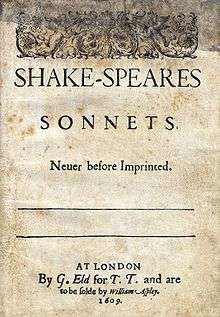Sonnet 3
Sonnet 3 is one of 154 sonnets written by the English playwright and poet William Shakespeare. It is often referred to as a procreation sonnet that falls within the Fair Youth sequence.
| Sonnet 3 | |||||||
|---|---|---|---|---|---|---|---|
 Sonnet 3 in the 1609 Quarto | |||||||
| |||||||
In the sonnet, the speaker is urging the man being addressed to preserve something of himself and something of the image he sees in the mirror by fathering a child. The “young man” of this and other sonnets is a subject of debate. Some think it may be based on William Herbert, others consider Henry Wriothesley. There are other candidates as well.
Structure
The poem takes the form of a Shakespearean sonnet: fourteen decasyllabic, iambic pentameter lines, that form three quatrains and a concluding rhyming couplet. It follows the form's rhyme scheme: ABAB CDCD EFEF GG. Each line of the first quatrain of Sonnet 3 exhibits a final extrametrical syllable or feminine ending. The first line additionally exhibits an initial reversal:
/ × × / × / × / × / (×) Look in thy glass and tell the face thou viewest (3.1)
- / = ictus, a metrically strong syllabic position. × = nonictus. (×) = extrametrical syllable.
Analysis
In this sonnet, the poet is urging the 'fair youth' to preserve something of himself and something of the image he sees in the mirror by fathering a child, "Now is the time that face should form another".
The message is reiterated in the last lines of the poem: "But if thou live, remember'd not to be, / Die single, and thine image dies with thee." Not only will the youth die, but so will his image — the one in his mirror, and also his image that may be seen borne by his yet-to-be child.[2]
References
- Pooler, C[harles] Knox, ed. (1918). The Works of Shakespeare: Sonnets. The Arden Shakespeare [1st series]. London: Methuen & Company. OCLC 4770201.
- Larsen, Kenneth J. "Note". Essays on Shakespeare's Sonnets. Retrieved 17 November 2014.
Further reading
- Baldwin, T. W. On the Literary Genetics of Shakspeare's Sonnets. Urbana: University of Illinois Press, 1950.
- Hubler, Edwin. The Sense of Shakespeare's Sonnets. Princeton: Princeton University Press, 1952.
- First edition and facsimile
- Shakespeare, William (1609). Shake-speares Sonnets: Never Before Imprinted. London: Thomas Thorpe.CS1 maint: ref=harv (link)
- Lee, Sidney, ed. (1905). Shakespeares Sonnets: Being a reproduction in facsimile of the first edition. Oxford: Clarendon Press. OCLC 458829162.
- Variorum editions
- Alden, Raymond Macdonald, ed. (1916). The Sonnets of Shakespeare. Boston: Houghton Mifflin Company. OCLC 234756.
- Rollins, Hyder Edward, ed. (1944). A New Variorum Edition of Shakespeare: The Sonnets [2 Volumes]. Philadelphia: J. B. Lippincott & Co. OCLC 6028485.
- Modern critical editions
- Atkins, Carl D., ed. (2007). Shakespeare's Sonnets: With Three Hundred Years of Commentary. Madison: Fairleigh Dickinson University Press. ISBN 978-0-8386-4163-7. OCLC 86090499.
- Booth, Stephen, ed. (2000) [1st ed. 1977]. Shakespeare's Sonnets (Rev. ed.). New Haven: Yale Nota Bene. ISBN 0-300-01959-9. OCLC 2968040.
- Burrow, Colin, ed. (2002). The Complete Sonnets and Poems. The Oxford Shakespeare. Oxford: Oxford University Press. ISBN 978-0192819338. OCLC 48532938.
- Duncan-Jones, Katherine, ed. (2010) [1st ed. 1997]. Shakespeare's Sonnets. The Arden Shakespeare, Third Series (Rev. ed.). London: Bloomsbury. ISBN 978-1-4080-1797-5. OCLC 755065951.
- Evans, G. Blakemore, ed. (1996). The Sonnets. The New Cambridge Shakespeare. Cambridge: Cambridge University Press. ISBN 978-0521294034. OCLC 32272082.
- Kerrigan, John, ed. (1995) [1st ed. 1986]. The Sonnets ; and, A Lover's Complaint. New Penguin Shakespeare (Rev. ed.). Penguin Books. ISBN 0-14-070732-8. OCLC 15018446.
- Mowat, Barbara A.; Werstine, Paul, eds. (2006). Shakespeare's Sonnets & Poems. Folger Shakespeare Library. New York: Washington Square Press. ISBN 978-0743273282. OCLC 64594469.
- Orgel, Stephen, ed. (2001). The Sonnets. The Pelican Shakespeare (Rev. ed.). New York: Penguin Books. ISBN 978-0140714531. OCLC 46683809.
- Vendler, Helen, ed. (1997). The Art of Shakespeare's Sonnets. Cambridge, MA: The Belknap Press of Harvard University Press. ISBN 0-674-63712-7. OCLC 36806589.
External links

- A paraphrase of the sonnet
- Shakespeare's sonnets.com on Sonnet 3
.png)
